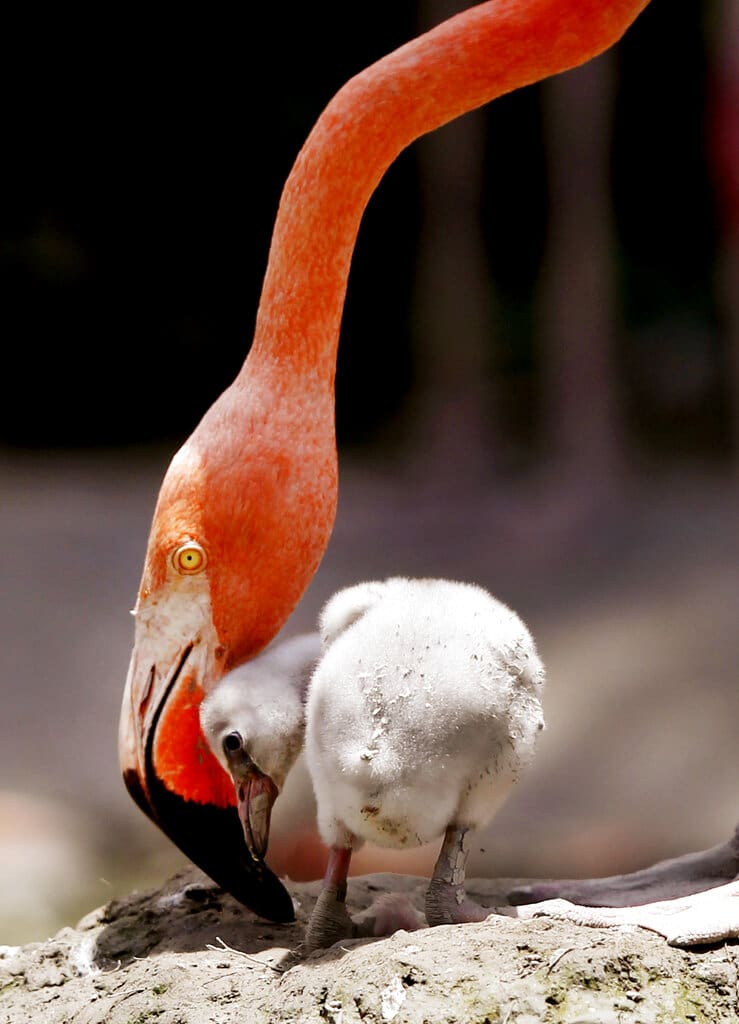Days after Hurricane Idalia blew through Florida in August, people began sighting flamingos in unusual spots. The birds were spotted as far north as Lake Michigan beach, Wisconsin. One of those fly-ins was “Peaches” who was found in deep water off Florida’s Gulf Coast.
Now the bright-pink bird is being tracked by a pair of researchers searching to see if wild breeding populations may return to the state since they went locally extinct in the early 1900s.
“I think everybody’s surfing the pink wave and, gosh, hopefully they’ll find a happy home here and we’ll be able to enjoy them for years to come,” Julie Wraithmell, the executive director of Audubon Florida said.
Peaches was floating in deep water, likely exhausted from flying a long distance with feathers that were getting waterlogged. The adult bird was then scooped up in a net and brought to the Seaside Seabird Sanctuary in Indian Shores for rehabilitation, said Frank Ridgley, Zoo Miami’s head of conservation and research.
“If a flamingo was strong and healthy, you would never be able to do that,” Ridgley said.
After exceeding everyone’s expectations, Peaches made a full recovery and was released just days later. That’s when Ridgley at Zoo Miami partnered with Audubon Florida’s Dr. Jerry Lorenz to track the bird.
Lorenz, a master bander who specializes in spoonbills, and Ridgley, who works at a Zoo where everything from hummingbirds to ostriches are banded, combined their expertise. Lorenz was able to have the paperwork to add American Flamingos to his license expedited by the United States Geological Survey’s bird banding laboratory.
“A bunch of people worked really hard and very fast to make this happen because we realized the importance,” Ridgley said.

After the Seabird Sanctuary agreed, Ridgley and Lorenz flew to Tampa and fitted Peaches with a satellite geo-locator and identification band on Sept. 8.
Peaches holds the distinction of being only the second American Flamingo ever to be tagged by the United States.
Peaches is currently exploring the areas around St. Petersburg and down to Sarasota, according to Ridgley. Researchers don’t expect the flamingo to venture further for a couple weeks.
Tracking this bird will tell researchers a few things. It might provide more information to the pool of evidence on the tie between flamingos across the Yucatan Peninsula and the Caribbean and those coming to Florida in increasing numbers during the winter.
But if Peaches decides to stay, and happens to find other birds of their kind along the way, will Florida have a wild, breeding population of flamingos for the first time since they disappeared from the state?
“There’s more questions than answers at the moment,” Wraithmell said. “That makes it a really exciting time to be a bird scientist.”
These striking birds on stilt legs used to roam the Florida peninsula in flocks of thousands. But after the millinery trade’s plume hunters largely wiped them out by the turn of the 18th century, sightings have become exceedingly rare.
“As a result of that practice, it decimated most of our wading birds and some of them still haven’t recovered fully, like the little blue heron and wood storks,” Ridgley said. “Flamingos were, like, forgotten as a wading bird for the United States.”
Conventional wisdom from the last 50 years was that flamingos spotted in Florida were likely escapees from private flocks, like the one at the Hialeah Park racetrack. For years, the Florida Fish and Wildlife Conservation Commission marked the American Flamingo as a non-native species on their website.
“A growing body of evidence over the years suggests that at least some American flamingos living in Florida have arrived on their own from outside of the state,” Lisa Thompson, FWC’s Habitat and Species Conservation spokesperson said.
Dr. Steven Whitfield, the Zoo Miami researcher who spearheaded the effort, dug up several first-hand accounts of settlers, explorers and naturalists sighting flocks of flamingos numbering hundreds to thousands of individuals, including one description of a nesting site and four egg specimens marked as collected from Florida.
Ridgley’s team at Zoo Miami partnered with the National Park Service to launch a research incentive that developed into what is now known as the Florida Flamingos Working Group. The group now consists of experts from Mexico, Cuba, the Bahamas and Florida who are all trying to address the research gaps in Flamingo conservation and recovery work.
They’re looking into flamingos travel patterns across breeding populations found in the Caribbean and Yucatan Peninsula with banding efforts but also conducting a genetic study. Group hopes to see if there was ever a genetically-distinct Florida flamingo and if that flamingo can be traced back to modern Caribbean and Yucatan flocks.
If the birds were to come back and inhabit the state permanently again, Ridgley says a regularly spotted flock could have huge implications for ecotourism in the state.
“We don’t want to just put all our eggs in one basket,” Ridgley said. “We want to look at multiple things, answer those research gaps, fill in the blanks so that we can come up with a multifaceted plan, a practical plan, one that we think has benefits for the species, for people, for even the economy.”
“

Julia Cooper
Julia Cooper is an intern at WLRN. Her work appears under a partnership between WLRN and the Key Biscayne Independent.


